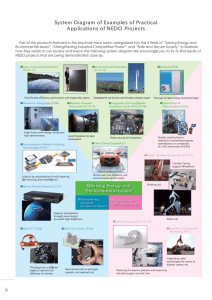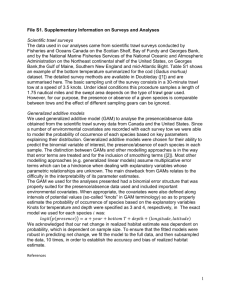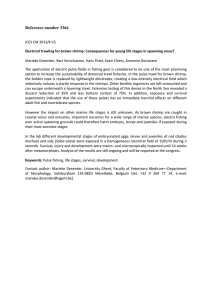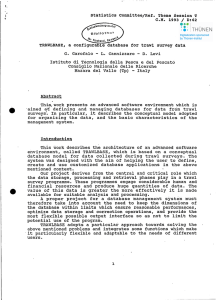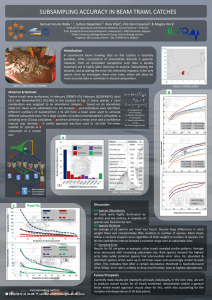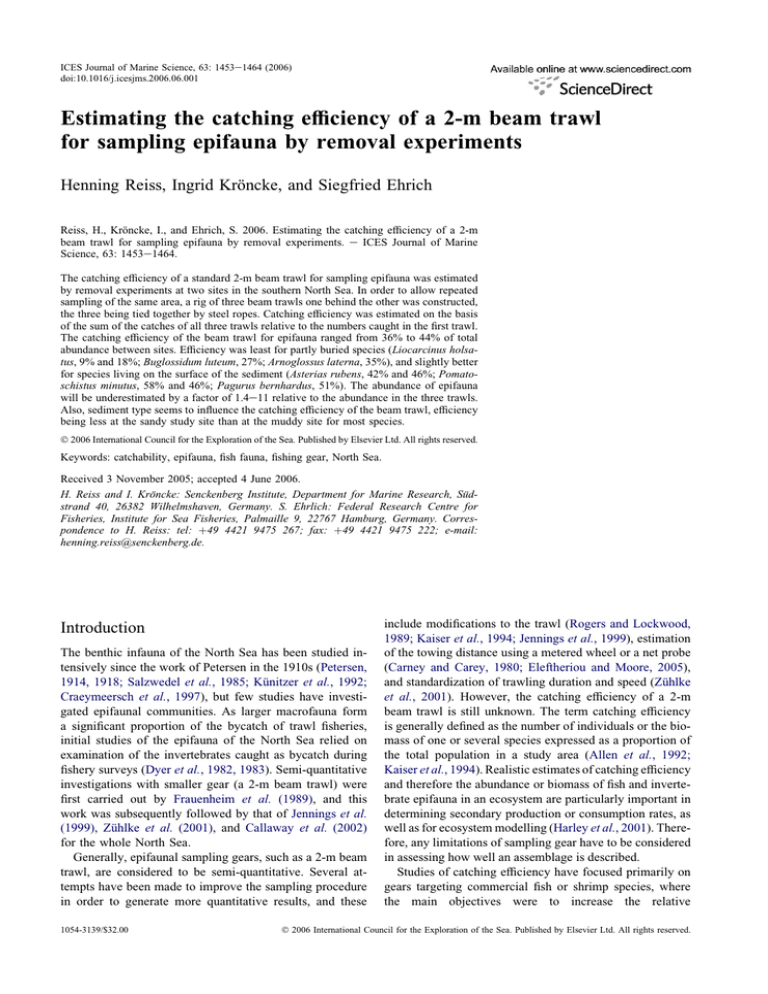
ICES Journal of Marine Science, 63: 1453e1464 (2006)
doi:10.1016/j.icesjms.2006.06.001
Estimating the catching efficiency of a 2-m beam trawl
for sampling epifauna by removal experiments
Henning Reiss, Ingrid Kröncke, and Siegfried Ehrich
Reiss, H., Kröncke, I., and Ehrich, S. 2006. Estimating the catching efficiency of a 2-m
beam trawl for sampling epifauna by removal experiments. e ICES Journal of Marine
Science, 63: 1453e1464.
The catching efficiency of a standard 2-m beam trawl for sampling epifauna was estimated
by removal experiments at two sites in the southern North Sea. In order to allow repeated
sampling of the same area, a rig of three beam trawls one behind the other was constructed,
the three being tied together by steel ropes. Catching efficiency was estimated on the basis
of the sum of the catches of all three trawls relative to the numbers caught in the first trawl.
The catching efficiency of the beam trawl for epifauna ranged from 36% to 44% of total
abundance between sites. Efficiency was least for partly buried species (Liocarcinus holsatus, 9% and 18%; Buglossidum luteum, 27%; Arnoglossus laterna, 35%), and slightly better
for species living on the surface of the sediment (Asterias rubens, 42% and 46%; Pomatoschistus minutus, 58% and 46%; Pagurus bernhardus, 51%). The abundance of epifauna
will be underestimated by a factor of 1.4e11 relative to the abundance in the three trawls.
Also, sediment type seems to influence the catching efficiency of the beam trawl, efficiency
being less at the sandy study site than at the muddy site for most species.
Ó 2006 International Council for the Exploration of the Sea. Published by Elsevier Ltd. All rights reserved.
Keywords: catchability, epifauna, fish fauna, fishing gear, North Sea.
Received 3 November 2005; accepted 4 June 2006.
H. Reiss and I. Kröncke: Senckenberg Institute, Department for Marine Research, Südstrand 40, 26382 Wilhelmshaven, Germany. S. Ehrlich: Federal Research Centre for
Fisheries, Institute for Sea Fisheries, Palmaille 9, 22767 Hamburg, Germany. Correspondence to H. Reiss: tel: þ49 4421 9475 267; fax: þ49 4421 9475 222; e-mail:
henning.reiss@senckenberg.de.
Introduction
The benthic infauna of the North Sea has been studied intensively since the work of Petersen in the 1910s (Petersen,
1914, 1918; Salzwedel et al., 1985; Künitzer et al., 1992;
Craeymeersch et al., 1997), but few studies have investigated epifaunal communities. As larger macrofauna form
a significant proportion of the bycatch of trawl fisheries,
initial studies of the epifauna of the North Sea relied on
examination of the invertebrates caught as bycatch during
fishery surveys (Dyer et al., 1982, 1983). Semi-quantitative
investigations with smaller gear (a 2-m beam trawl) were
first carried out by Frauenheim et al. (1989), and this
work was subsequently followed by that of Jennings et al.
(1999), Zühlke et al. (2001), and Callaway et al. (2002)
for the whole North Sea.
Generally, epifaunal sampling gears, such as a 2-m beam
trawl, are considered to be semi-quantitative. Several attempts have been made to improve the sampling procedure
in order to generate more quantitative results, and these
1054-3139/$32.00
include modifications to the trawl (Rogers and Lockwood,
1989; Kaiser et al., 1994; Jennings et al., 1999), estimation
of the towing distance using a metered wheel or a net probe
(Carney and Carey, 1980; Eleftheriou and Moore, 2005),
and standardization of trawling duration and speed (Zühlke
et al., 2001). However, the catching efficiency of a 2-m
beam trawl is still unknown. The term catching efficiency
is generally defined as the number of individuals or the biomass of one or several species expressed as a proportion of
the total population in a study area (Allen et al., 1992;
Kaiser et al., 1994). Realistic estimates of catching efficiency
and therefore the abundance or biomass of fish and invertebrate epifauna in an ecosystem are particularly important in
determining secondary production or consumption rates, as
well as for ecosystem modelling (Harley et al., 2001). Therefore, any limitations of sampling gear have to be considered
in assessing how well an assemblage is described.
Studies of catching efficiency have focused primarily on
gears targeting commercial fish or shrimp species, where
the main objectives were to increase the relative
Ó 2006 International Council for the Exploration of the Sea. Published by Elsevier Ltd. All rights reserved.
1454
H. Reiss et al.
In order to allow repeated sampling with a 2-m beam
trawl, which is commonly used for epifauna sampling in
offshore waters, we developed a sampling design in which
three beam trawls were tied one behind the other to guarantee repeated sampling of the same area. The objectives of
this study were (i) to estimate the catching efficiency of
a standard 2-m beam trawl for sampling epifaunal species
(small fish and invertebrates), and (ii) to investigate
whether this efficiency varies between species or sediment
types.
catchability of a target species rather than to estimate the
catching efficiency related to the quantitative species
composition in the assemblage (Harley et al., 2001). The
relative efficiency of small trawls has been studied by comparing different gears or gear modifications (Kuipers, 1975;
Creutzberg et al., 1987; Rogers and Lockwood, 1989;
Kaiser et al., 1994). However, this approach cannot give
reliable information about the real catching efficiency of
a gear because each gear has different but unknown catching efficiencies.
Combined underwater image (video or photographic
analysis) and trawl catches (Yeh and Ohta, 2002, Sonntag,
pers. comm.), or experimental approaches such as repeated
sampling (Fonds, 1994; Loneragan et al., 1995), can provide realistic estimates of catching efficiency. However,
such approaches have serious drawbacks. On the one
hand, image analyses can only give information about the
catching efficiency for easily visible larger epibenthos and
fish species, whereas small and buried species cannot be
considered. On the other hand, repeated sampling of the
same area is virtually impossible in offshore areas because
of inaccurate positioning if using ship-deployed gears, and
immigration of mobile species into the trawled area will
affect abundance estimates (Fonds, 1994). Therefore,
repeated sampling with small trawls has only been used
in shallow waters, such as estuaries and intertidal channels,
where the study site can be spatially restricted (Edwards
and Steele, 1968; Kuipers, 1975; Allen et al., 1992;
Loneragan et al., 1995). Fonds (1994), however, did try
repeated sampling in an offshore area in the southern North
Sea with commercial beam trawls.
1º
2º
4º
3º
56º
Material and methods
Study sites and sampling
The study sites are located in two boxes (10 10 nautical
miles) situated in different areas of the southern North
Sea (Figure 1). These boxes are part of the German
Small-scale Bottom Trawl Survey (GSBTS), which was
started in 1986 by SE to investigate mesoscale variability
in the fish fauna (Ehrich and Stransky, 2001). The sediment
structure of the two boxes is different, with muddy sand in
box A and coarse sand in box N (Table 1).
Samples of the epifauna were obtained with FRV
‘‘Walther Herwig III’’ in January 2004. Sampling was
carried out with a standard 2-m beam trawl with a chain
mat attached. It was fitted with a 20-mm stretched mesh
and a codend liner of 4-mm knotless mesh. Details about
the equipment are given in Jennings et al. (1999). To estimate the towing distance and hence the area sampled, a net
probe (SCANMARÓ) was fixed to the headline of the trawl
5º
6º
7º
8º
9º
56º
30
m
50 m
55º
55º
Box N
Box A
North Sea
54º
54º
30 m
20
m
53º
53º
1º
2º
3º
4º
5º
6º
7º
Figure 1. Study areas in the North Sea.
8º
9º
Estimating the catching efficiency of a beam trawl for sampling epifauna
Table 1. Geographical positions (centre of the boxes) and main
characteristics of the study sites. For the mean towing distance,
the standard deviation is given.
Parameter
Latitude
Longitude
Date of sampling
Mean depth (m)
Sediment type
Mean towing
distance (m)
Box A
Box N
54(22.020 N
007(06.480 E
7 January 2004
39
Muddy sand
218 15
54(48.000 N
007(40.020 E
10 January 2004
25
Coarse sand
306 63
to determine the exact times when the gear touched and left
the bottom. In order to guarantee repeated sampling of the
same trawl track, three identical beam trawls were rigged
one behind the other, attached by steel ropes 6 m long
(Figure 2a). The net probe was fixed to the headline of
the first trawl. Figure 2b shows the hypothetical pattern
of abundance or biomass in the consecutive trawls, assuming a sequential catching efficiency of 50%. In each box,
the experiment was repeated three times.
Because of differences in the diurnal activity of some
epibenthic species, sampling took place only during daylight. The samples were sieved through a 5 mm mesh and
the organisms collected. Most species were identified
on board, counted, and weighed (wet weight) with
1455
a motion-compensated marine scale. If onboard identification of species was not possible, specimens were fixed in
4% buffered formalin for identification in the laboratory.
In addition, three hauls with a single trawl were carried
out in the vicinity of the positions of the three-beam-trawl
hauls (maximum distance away, 2 nautical miles), to compare the catches of both deployments. The single-trawl and
three-beam-trawl samples were treated in the same way.
Analysis
The abundance and biomass data were standardized to
a tow length of 250 m (area sampled ¼ 500 m2). Prior to
analysis, large demersal and pelagic fish caught with the
trawls were excluded. To calculate catching efficiency,
regression methods such as those of Leslie or DeLury
(see Loneragan et al., 1995) could not be applied to our
data, because only two repeats were possible. Therefore,
to estimate catching efficiency, the sum of the catches of
all three trawls was assumed to represent the total abundance and biomass of the epifauna. Total numbers, the
sum of all three trawl catches, were compared with
the numbers caught in the first trawl, and from those data
the percentage efficiency was calculated. Therefore, the estimated catching efficiency will only provide a value of
maximum efficiency, because the results indicate that the
total abundance (biomass) was probably higher than the
numbers (biomass) caught by the three trawls. For species
with a total abundance of <10 individuals, no catching efficiency was calculated. A ManneWhitney U test was used
to assess significant differences in the catching efficiency
between the different sampling sites and between catches
of the different deployments.
Results
Total abundance and biomass
Figure 2. (a) Schematic drawing of the gear used in the threebeam-trawl experiment, and (b) the hypothetical pattern of epifaunal abundance or biomass within each trawl assuming a catching
efficiency of 50%.
In box A, fewer individuals were caught with the second
and third trawl than in the first trawl, as expected from
the experimental design (Figure 3). However, the decrease
in abundance was not consistent from one net to the next. In
box N, a similar pattern was found for one replicate only,
whereas in the two other replicates, most individuals were
caught in the second trawl. The catching efficiency of total
epifaunal abundance and biomass was 44% and 32% in box
A, and 36% and 45% in box N, respectively (Table 2).
The surprising catch pattern of the three trawls compared
with our initial expectations seemed to be caused mainly by
differences in the vulnerability of different species. Extrusion of small specimens through the net does not explain
the high abundances sometimes found in the second and
third trawl. The effect of mesh selectivity could not be
analysed in detail, because no size measurements of the epifauna were made during the study. However, the biomass
pattern in the three trawls, which was similar to that for
1456
H. Reiss et al.
Figure 3. Pattern of total abundance (bars) and biomass (lines) for the first, second, and third trawl for each replicate (AeC and E, G and
H) in boxes A and N.
abundance, as well as visual observations, revealed no
substantial differences in the size of the specimens in the
catches of the consecutive trawls.
The comparison of the data of the first trawl with the data
of single-trawl deployments of the standard programme
shows no significant differences in total abundance or biomass (U test(3/3), p > 0.05). Therefore, we conclude that
towing two trawls behind the first did not affect the catching
characteristics of the first trawl, compared with a singletrawl haul.
Species numbers
The first trawl caught between 70% and 76% of the total
species taken in all three trawls in box A and between
54% and 84% of all species taken in all three trawls in
box N (Figure 4). In both study areas, most species caught
by the first trawl were species with an epifaunal life mode,
living most of their life at the surface of the sediment or
only occasionally burrowing in its upper layers (Figure 4).
In contrast, the additional species caught by the second and/
or the third trawl contained a higher proportion of infaunal
species, such as bivalves and polychaetes. This is taken as
an indication that the first trawl disturbed the surface sediments and dug out specimens, resulting in their greater vulnerability to the second and third trawl. Because this pattern
was consistent among sites, differences in sediment type appear to have a minor effect on the relative composition of
catches, although the chain mat was expected to penetrate
deeper into the sediment of the muddy sand of box A
than into the sandy substratum of box N.
Abundance and biomass at a species level
For the highly mobile sand goby (Pomatoschistus minutus),
there was a clear decrease in abundance from the first to the
second trawl in each study area (Figure 5a), the catching
efficiency reaching 58% and 46% in boxes A and N, respectively (Table 2). In box A, abundance in the third trawl was
slightly greater than in the second, perhaps through buried
individuals being disturbed by the first and second trawl
and caught by the third. The disturbance effect of the trawls
is clearly reflected by the abundance pattern of the swimming crab Liocarcinus holsatus in the three trawls
(Figure 5b). Greatest abundance was in the third trawl
and lowest in the first trawl for all replicates, contrary to
our initial expectations. This was probably caused by the
disturbance of this night-active species, which buries in
the sediment during daylight. Therefore, the estimated
catching efficiency for L. holsatus was just 18% in box A
and 9% in box N (Table 2). In contrast, the catching efficiency of the shrimps Crangon crangon and C. allmanni,
Estimating the catching efficiency of a beam trawl for sampling epifauna
1457
Table 2. Mean catching efficiency (s.d.) of the 2-m beam trawl at the two study sites in boxes A and N.
Catching efficiency in box A
Taxon
Fish
Arnoglossus laterna
Buglossidium luteum
Limanda limanda
Callionymus lyra
Callionymus reticulatus
Syngnathidae
Pomatoschistus minutus)
Catching efficiency in box N
Abundance (%)
Biomass (%)
Abundance (%)
Biomass (%)
35 2
27 15
44 17
45 14
d
d
58 6
41 5
28 5
37 8
46 16
d
d
58 6
d
d
29 24
29y
36 19
43 11
46 3
d
d
35 25
40
25 10
45 9
53 6
Decapoda
Corystes cassivelaunus
Liocarcinus holsatus)
Pagurus bernhardus
Crangon allmanni)
Crangon crangon
Processa spp.
64y
18 5
d
56 4
43 6
72z 8
55 5
20 10
d
58 4
40 6
83 24
Asteroidea
Asterias rubens
Astropecten irregularis
42 7
34 9
46 8
34 9
46 6
35 10
53 7
37 12
19z 19
d
11 16
d
d
0z 0
d
00
44 5
32 8
36 4
45 9
Other taxa
Nucula nitidosa
Branchiostoma lanceolata
All taxa
d
92
51z 1
26 8
31 7
d
d
93
64 8
27 7
28 5
d
)Indicates significant differences (U test(3/3), p < 0.05) in catching efficiency between sites.
yBased on one replicate only.
zBased on two replicates only.
which also live partly buried in the sediment, was comparatively high in box A at 43% and 56%, respectively.
However, in box N the efficiency was lower, at 31% for
C. crangon and 26% for C. allmanni (Figure 6, Table 2).
Even the catching efficiency of slow-moving epifaunal
species living most of the time on the sediment surface,
such as the sea stars Asterias rubens and Astropecten irregularis, was <50% (Figure 7, Table 2).
There was considerable variability in the catching efficiencies among species and sites (Table 2). Sediment type
seemed to have an influence on catching efficiency for
some species. Significant differences between the sites
were found for P. minutus, L. holsatus, and C. allmanni
(U test(3/3), p < 0.05), indicating lower catch efficiencies
in box N than in box A.
Discussion
Until now, studies of the catching efficiency of the small
beam trawls and dredges used for sampling epifauna were
mainly restricted to analysis of findings for a limited group
of commercially fished species, such as juvenile flatfish,
prawns, or scallops. Dickie (1955) documented a scallop
dredge efficiency of 5e12% for the target species, depending on the type of sea bottom. For juvenile flatfish,
estimates of catching efficiency for a 2-m beam trawl varied
between 23% and 57% (Creutzberg et al., 1987), between
23% and 37% for plaice (Edwards and Steele, 1968), and
were 100% for juvenile plaice (Kuipers, 1975). These
rather low estimates of catching efficiency indicate that
epifauna sampling with a beam trawl provides a fragmentary rather than a complete inventory of the epifaunal
community.
The standardized 2-m beam trawl described by Jennings
et al. (1999) was used recently in studies of epifauna communities of the North Sea (Zühlke et al., 2001; Callaway
et al., 2002; Hinz et al., 2004; Reiss and Kröncke, 2004),
and the analyses included standardization of trawl duration
and speed, as well as recording of the start and end position
of the trawl. However, because the catching efficiency of
the gear was still unknown, abundance estimates from those
studies were still not calibrated. The results from our study
provide initial estimates of the catching efficiency of a 2-m
1458
H. Reiss et al.
Figure 4. Total species numbers by the first trawl (grey bars), and additional species caught by the second and/or third trawl (dark grey
bars). The pie charts show the proportion of infaunal (shaded) and epifaunal (white) species numbers in each category.
beam trawl for several species in two different habitats.
Catching efficiency for most species was <50%, although
there were marked differences between species. However,
accurate estimates of gear catching efficiency and, therefore, of abundance or biomass of epifauna in an ecosystem
are particularly important in determining secondary production and, hence, for modelling the ecosystem (Harley et al.,
2001).
Estimating catching efficiency e the
three-beam-trawl approach
Some of the main difficulties in repeated sampling in offshore areas arise from inaccuracy in positioning the trawl
tracks and migration of scavenging specimens into the
trawled area. To guarantee repeated sampling of the same
area, we used three beam trawls one behind the other,
which made immigration of specimens into the trawl track
nearly impossible because the distance between each trawl
was only some 6 m from beam to beam. However, specimens could still escape from an approaching trawl by
moving to the side. Kuipers (1975) showed that the lateral
escape of fish from the trawl track of a 2-m beam trawl was
significant in the case of large specimens (>15 cm). However, because large fish, which are not sampled quantitatively by a 2-m beam trawl, were omitted from our
analyses, lateral escape of fish specimens is considered to
be of minor importance here. However, highly mobile
invertebrate specimens such as L. holsatus or shrimp species might have escaped from all three trawls, which would
have led to an underestimation of the catching efficiency.
Comparing epifaunal abundance in the first of the three
trawls with that in single-trawl hauls revealed that towing
additional trawls closely behind the first had no significant
influence on the performance of the front trawl. Therefore,
the catching efficiency for the three beam trawls towed one
behind each other can be applied to the results for single
beam trawl hauls. However, we do acknowledge that
bottom contact of the three-beam-trawl arrangement was
recorded by a net-probe fixed only on the first beam trawl.
Consequently, there may have been a time-lag in bottom
contact between the first and the third trawl, the latter perhaps making bottom contact before the first, and vice versa
during hauling. This might conceivably have biased our
results towards greater abundance in the third trawl. However, we believe that such a time-lag would have been very
Estimating the catching efficiency of a beam trawl for sampling epifauna
1459
Figure 5. Pattern of abundance (bars) and biomass (lines) for (a) sand goby (Pomatoschistus minutus) and (b) swimming crab (Liocarcinus
holsatus) for the first, second, and third trawl for each replicate (AeC and E, G and H) in boxes A and N.
1460
H. Reiss et al.
Figure 6. Pattern of abundance (bars) and biomass (lines) for (a) common shrimp (Crangon crangon) and (b) brown shrimp (Crangon
allmanni) for the first, second, and third trawl for each replicate (AeC and E, G and H) in boxes A and N.
Estimating the catching efficiency of a beam trawl for sampling epifauna
1461
Figure 7. Pattern of abundance (bars) and biomass (lines) for (a) common sea star (Asterias rubens) and (b) sand star (Astropecten
irregularis) for the first, second, and third trawl for each replicate (AeC and E, G and H) in boxes A and N.
1462
H. Reiss et al.
short and of minor importance relative to the total distance
sampled.
The sum of the catch of all three trawls was assumed to
represent the total populations in the sampled area. The
abundance of several species in the three trawls indicates
that this assumption is rather simplistic, because the abundance was often higher in the rear trawls than in the first
(e.g. L. holsatus). Therefore, the catching efficiency could
have been overestimated, so the estimated catching efficiency calculated here is likely to be a maximum value;
real catching efficiency might be less.
The 2-m beam trawl with a chain mat, as used in this
study, maximized the catch of A. rubens and Ophiura
albida by factors of 10 and 16, respectively, when
compared with the results of an unmodified beam trawl
(Kaiser et al., 1994). From the latter findings, we would
expect the 2-m beam trawl to be the most appropriate
gear for sampling less mobile epifaunal species. However,
our results show that the catching efficiency for species
such as Asterias rubens, Astropecten irregularis, and
Pagurus bernhardus was well below 50% (Table 2).
Differences in the catching efficiency
depending on non-gear-specific parameters
Catching efficiency for different
epibenthic species
The results of our study have shown that the estimates of
catching efficiency for the 2-m beam trawl were 44% and
36% of total abundance in boxes A and N, respectively.
These results are in a range similar to those of previous
studies on single species, mentioned above. However, there
were differences in catching efficiency between epifaunal
species. The catching efficiency for different species is
determined by the behaviour of the individual animals,
which influences their likelihood of being caught by a trawl.
Slow-moving species are expected to be caught more efficiently than highly mobile ones, which may escape from
the trawl. Also, species living on the sediment surface
would be expected to be caught more effectively than species partly buried in the sediment. Our lowest estimates of
catching efficiency were for species living partly buried in
the sediment, e.g. solenette (Buglossidium luteum), 27%,
and scaldfish (Arnoglossus laterna), 35%, in box A (Table
2). In contrast, the catching efficiency in box A for more
mobile fish species such as the sand goby and the dragonet
(Callionymus lyra) was somewhat higher, 58% and 45%,
respectively. The lowest catching efficiency within the invertebrate epifauna was for the swimming crab Liocarcinus
holsatus, which lives buried in the sediment, with 18% in
box A and 9% in box N (Table 2).
The high abundances in the second and the third trawl,
and the resulting low catching efficiency for some species,
might have been caused by disturbance of the sediment by
the first trawl, which could have made buried specimens
more accessible to the trawls following immediately
behind. Weinstein and Davis (1980) considered the loss
of fish through their burial in soft mud to be an important
consideration in estimating true population size using
a seine net. On the other hand, the downward force of the
rear trawls might be greater than that of the first one, which
could have resulted in deeper penetration of the second and
third trawl into the sediments. However, the low catching
efficiency calculated here shows that the abundance and
biomass, especially for species buried partly in the sediment, will be significantly underestimated if a single 2-m
beam trawl is used.
Aside from the general design and construction of a beam
trawl, its catching efficiency may depend on sediment type
(Bergman and van Santbrink, 1994; Ball et al., 2000), light
intensity (Glass and Wardle, 1989), and the seasonal or diurnal activity patterns of the epifauna (Gibson et al., 1996;
Casey and Myers, 1998; Korsbrekke and Nakken, 1999).
Penetration depth of a beam trawl is an important factor
determining the catching efficiency, particularly for buried
species, and this will depend on sediment type (Creutzberg
et al., 1987; Rogers and Lockwood, 1989; Bergman and
van Santbrink, 1994). In this study, catching efficiency of almost all species at the sandy site (box N) was lower than at
the muddy sand site (box A), but differences were significant
only for C. allmanni, L. holsatus, and P. minutus. These differences in catching efficiency between the sites were probably caused by differences in the sediment type and the
resulting variation in penetration ability of the beam trawl.
Penetration depth of commercial beam trawls is up to 8 cm
in muddy sediment and up to 3 cm in sandy sediment (Kaiser
and Spencer, 1994; Van Santbrink and Bergman, 1994).
Our results show that the likelihood of species being
caught by a beam trawl depends inter alia on the life
mode or behaviour of the species. Therefore, environmental
factors causing changes in behaviour will probably have an
effect on the catching efficiency of the gear. Diurnal variations in activity of a species may lead to differences in catching efficiency between day and night (Korsbrekke and
Nakken, 1999), which is most likely the case for nightactive decapods such as the swimming crabs L. holsatus and
L. depurator (Abelló et al., 1991). Loneragan et al. (1995)
found that catch rates of tiger prawns by day, when the
prawns are buried in the sediment, were about half of those
by night. Also, seasonal differences in behaviour were found
for several epifaunal species, as a result of their reproductive
cycle (Hartnoll, 1972; Reiss and Kröncke, 2004), reduced
locomotory activity attributable to low temperature (Allen
et al., 1992; Freeman et al., 2001), or changes in food availability (Abelló et al., 1991; Maes et al., 1998). For example,
the masked crab Corystes cassivelaunus remains buried in
the sediment throughout the whole year, but mature crabs
leave the sediment during the breeding season in spring
and early summer (Hartnoll, 1972; Reiss and Kröncke,
Estimating the catching efficiency of a beam trawl for sampling epifauna
2004). Although differences in catching efficiency attributable to seasonal or diurnal differences in the vulnerability
of species could not be tested during this study, they are
likely to occur. Such potential differences should be taken
into account when comparing beam-trawl samples from different seasons or at different times of day.
Implications of catching efficiency
for epifauna studies
The 2-m beam trawl was initially designed to catch juvenile
flatfish (Riley and Corlett, 1966), but since then, several studies have focused on modifications designed to improve the
catch of invertebrate epifauna. When sampling benthic communities, each gear (grab, core, or trawl) will sample only
a component of the benthic assemblage (Eleftheriou and
Moore, 2005). However, if the catching efficiency of
a gear is too low, other biotic and abiotic factors that influence estimates of abundance could mask possible spatial or
temporal variations in the communities (Kaiser et al.,
1994). Our results show that the catching efficiency of a 2m beam trawl was below 50% for most epifaunal species,
varying between 9% for the swimming crab L. hosatus in box
N and 72% for the shrimp Processa spp. in box A (Table 2).
Therefore, the abundance and biomass of epifauna will be significantly underestimated by the use of beam-trawl samples.
When studying spatial differences between epifaunal
communities, differences in the catching efficiency between
species may result in biased estimation of functional properties. For example, partly buried species such as swimming
crabs or flatfish will be underestimated compared with species that live on the sediment surface. This bias might be
even more important if comparing different habitats, because
of differences in the catching efficiency by sediment types for
some species. Therefore, infauna species should be omitted
from such analyses, although these species are regularly retrieved in the trawl samples.
Realistic data on the population abundance and biomass
of benthic species are particularly important in determining
secondary production in an ecosystem. Our results show
that estimations of secondary production based on beamtrawl samples will be underestimated by factors of
1.4e11, depending on the species under consideration,
showing that improvement of the catching efficiency of
the 2-m beam trawl is needed. However, the three-beamtrawl approach may be used in epifaunal studies to
determine conversion factors based on the catching
efficiency for each species in specific habitats.
Acknowledgements
We thank the captain and crew of the FRV ‘‘Walther
Herwig III’’ for their help with the sampling, and E. Karp
for his help in developing the three-beam-trawl rig. We
are also grateful to Dr. P. Pepin and two anonymous
referees for helpful comments on the manuscript.
1463
References
Abelló, P., Reid, D. G., and Naylor, E. 1991. Comparative locomotor activity patterns in the portunid crabs Liocarcinus holsatus
and L. depurator. Journal of the Marine Biological Association
of the UK, 71: 1e10.
Allen, D. M., Service, S. K., and Ogburn-Matthews, M. V. 1992.
Factors influencing the collection efficiency of estuarine fishes.
Transactions of the American Fisheries Society, 121: 234e244.
Ball, B., Munday, B., and Tuck, I. 2000. Effects of otter trawling on
the benthos and environment in muddy sediments. In The Effects
of Fishing on Non-Target Species and Habitats, pp. 69e82. Ed.
by M. J. Kaiser, and S. J. de Groot. Blackwell Science, Oxford.
Bergman, M. J. N., and van Santbrink, J. W. 1994. Direct effects of
beam trawling on macrofauna in sandy areas off the Dutch coast.
In Environmental Impact of Bottom Gears on Benthic Fauna in
Relation to Natural Resources Management and Protection of the
North Sea, pp. 179e208. Ed. by S. J. de Groot, and H. J. Lindeboom. NIOZ Rapport 1994, 11 RivoeDLO report C026/94.
Callaway, R., Alsvag, J., de Boois, I., Cotter, J., Ford, A., Hinz, H.,
Jennings, S., Kröncke, I., Lancaster, J., Piet, G., Prince, P., and
Ehrich, S. 2002. Diversity and community structure of epibenthic invertebrates and fish in the North Sea. ICES Journal
of Marine Science, 59: 1199e1214.
Carney, R. S., and Carey, A. G. J. 1980. Effectiveness of metering
wheels for measurement of area sampled by beam trawls. Fishery Bulletin US, 78: 791e796.
Casey, J. M., and Myers, R. A. 1998. Diel variation in trawl catchability: is it as clear as day and night. Canadian Journal of
Fisheries and Aquatic Sciences, 55: 2329e2340.
Craeymeersch, J. A., Heip, C. H. R., and Buijs, J. 1997. Atlas of the
North Sea benthic infauna. ICES Cooperative Research Report,
218. 86 pp.
Creutzberg, F., Duineveld, G. C. A., and van Noort, G. J. 1987. The
effect of different numbers of tickler chains on beam-trawl
catches. Journal du Conseil International pour l’Exploration de
la Mer, 43: 159e168.
Dickie, L. M. 1955. Fluctuations in abundance of the giant scallop,
Placopecten magellanius (Gmelin), in the Digby area of the Bay
of Fundy. Journal of the Fisheries Research Board of Canada,
12: 797e857.
Dyer, M. F., Fry, W. G., Fry, P. D., and Cranmer, G. J. 1982. A
series of North Sea benthos surveys with trawl and headline
camera. Journal of the Marine Biological Association of the
UK, 62: 297e313.
Dyer, M. F., Fry, W. G., Fry, P. D., and Cranmer, G. J. 1983.
Benthic regions within the North Sea. Journal of the Marine
Biological Association of the UK, 63: 683e693.
Edwards, R., and Steele, J. H. 1968. The ecology of 0-group plaice
and common dabs at Loch Ewe. 1. Population and food. Journal
of Experimental Marine Biology and Ecology, 2: 215e238.
Ehrich, S., and Stransky, C. 2001. The influence of towing time,
catch size and catch treatment on species diversity estimates
from groundfish surveys. Archive of Fishery and Marine
Research, 49: 37e44.
Eleftheriou, A., and Moore, D. C. 2005. Macrofauna techniques. In
Methods for the Study of Marine Benthos, pp. 160e228. Ed. by
A. Eleftheriou, and A. McIntyre. Blackwell Science, Oxford, UK.
Fonds, M 1994. Catch composition of 12-m beam trawl and 4-m
beam trawl for sole fishing. In Environmental Impact of Bottom
Gears on Benthic Fauna in Relation to Natural Resources Management and Protection of the North Sea, pp. 95e130. Ed. by
S. J. de Groot, and H. J. Lindeboom. NIOZ Rapport 1994, 11
RivoeDLO report C026/94.
Frauenheim, K., Neumann, V., Thiel, H., and Türkay, M. 1989.
The distribution of the larger epifauna during summer and winter
in the North Sea and its suitability for environmental monitoring.
Senckenbergiana Maritima, 20: 101e118.
1464
H. Reiss et al.
Freeman, S. M., Richardson, C. A., and Seed, R. 2001. Seasonal
abundance, spatial distribution, spawning and growth of
Astropecten irregularis (Echinodermata: Asteroidea). Estuarine.
Coastal and Shelf Science, 53: 39e49.
Gibson, R. N., Robb, L., Burrows, M. T., and Ansell, A. D. 1996. Tidal,
diel and longer term changes in the distribution of fishes on a Scottish sandy beach. Marine Ecology Progress Series, 130: 1e17.
Glass, C. W., and Wardle, C. S. 1989. Comparisons of the reactions
of fish to a trawl gear, at night and low light intensities. Fisheries
Research, 7: 249e266.
Harley, S. J., Myers, R., Barrowman, N., Bowen, K., and Amiro,
R. 2001. Estimation of research trawl survey catchability for
biomass reconstruction of the eastern Scotian Shelf, Canadian
Science Advisory Secretariat Research Document, 2001/084. 54 pp.
Hartnoll, R. G. 1972. The biology of the burrowing crab, Corystes
cassivelaunus. Bijdragen tot de Dierkunde, 42: 139e155.
Hinz, H., Kröncke, I., and Ehrich, S. 2004. Seasonal and annual
variability in an epifaunal community in the German Bight.
Marine Biology, 144: 735e745.
Jennings, S., Lancaster, J., Woolmer, A., and Cotter, J. 1999. Distribution, diversity and abundance of epibenthic fauna in the
North Sea. Journal of the Marine Biological Association of the
UK, 79: 385e399.
Kaiser, M. J., Rogers, S. I., and McCandless, D. T. 1994.
Improving quantitative surveys of epibenthic communities using
a modified 2 m beam trawl. Marine Ecology Progress Series,
106: 131e138.
Kaiser, M. J., and Spencer, B. E. 1994. A preliminary assessment
of the immediate effects of beam trawling on a benthic community in the Irish Sea. In Environmental Impact of Bottom Gears
on Benthic Fauna in Relation to Natural Resources Management
and Protection of the North Sea, pp. 87e94. Ed. by S. J. de
Groot, and H. J. Lindeboom. NIOZ Rapport 1994, 11
RivoeDLO report C026/94.
Korsbrekke, K., and Nakken, O. 1999. Length and species-dependent
diurnal variation of catch rates in the Norwegian Barents Sea
bottom-trawl surveys. ICES Journal of Marine Science, 56:
284e291.
Kuipers, B. 1975. On the efficiency of a two-metre beam trawl for
juvenile plaice (Pleuronectes platessa). Netherlands Journal of
Sea Research, 9: 69e85.
Künitzer, A., Basford, D., Craeymeersch, J. A., Dewarumez, J. M.,
Dörjes, J., Duineveld, G. C. A., Eeleftheriou, A., Heip, C., Herman, P., Kingston, P., Niermann, U., Rachor, E., Rumohr, H.,
and de Wilde, P. A. J. 1992. The benthic infauna of the North
Sea: species distribution and assemblages. ICES Journal of Marine Science, 49: 127e143.
Loneragan, N. R., Wang, Y-G., Kenyon, R. A., Staples, D. J.,
Vance, D. J., and Heales, D. S. 1995. Estimating the efficiency
of a small beam trawl for sampling tiger prawns Penaeus esculentus and P. semisulcatus in seagrass by removal experiments.
Marine Ecology Progress Series, 118: 139e148.
Maes, J. A. T., Van Damme, P. A., Cottenie, K., and Ollevier, F.
1998. Seasonal patterns in the fish and crustacean community
of a turbid temperate estuary (Zeeschelde Estuary, Belgium).
Estuarine, Coastal and Shelf Science, 47: 143e151.
Petersen, C. G. J. 1914. Valuation of the sea. 2. The animal
communities of the sea bottom and their importance for marine
zoogeography. Report of the Danish Biological Station, 21. 44 pp.
Petersen, C. G. J. 1918. The sea bottom and its production of fishfood. Report of the Danish Biological Station, 25. 62 pp.
Reiss, H., and Kröncke, I. 2004. Seasonal variability of epibenthic
communities in different areas of the southern North Sea. ICES
Journal of Marine Science, 61: 882e905.
Riley, J. D., and Corlett, J. 1966. The numbers of 0-group plaice in
Port Erin Bay, 1964e1966. Report of the Marine Biology
Station, Port Erin, 78: 51e56.
Rogers, S. I., and Lockwood, S. J. 1989. Observations on the
capture efficiency of a two-metre beam trawl for juvenile flatfish.
Netherlands Journal of Sea Research, 23: 347e352.
Salzwedel, H., Rachor, E., and Gerdes, D. 1985. Benthic macrofauna communities in the German Bight. Veröffentlichungen
des Instituts für Meeresforschung in Bremerhaven, 20: 199e267.
Van Santbrink, J. W., and Bergman, M. J. N. 1994. Direct effects of
beam trawling on macrofauna in a soft bottom area in the southern North Sea. In Environmental Impact of Bottom Gears on
Benthic Fauna in Relation to Natural Resources Management
and Protection of the North Sea, pp. 147e178. Ed. by S. J. de
Groot, and H. J. Lindeboom. NIOZ Rapport 1994, 11
RivoeDLO report C026/94.
Weinstein, M. P., and Davis, R. W. 1980. Collection efficiency of
seine and retenone samples from tidal creeks, Cape Fear River,
North Carolina. Estuaries, 3: 98e105.
Yeh, S-M., and Ohta, S. 2002. Influence of velocity and types of
beam trawl towing on deep-sea demersal fish and decapod
crustacean samples. Journal of Oceanography, 58: 505e517.
Zühlke, R., Alsvag, J., de Boois, I., Cotter, J., Ehrich, S., Ford, A.,
Hinz, H., Jarre-Teichmann, A., Jennings, S., Kröncke, I., Lancaster, J., Piet, G., and Prince, P. 2001. Epibenthic diversity in the
North Sea. Senckenbergiana Maritima, 31: 269e281.

